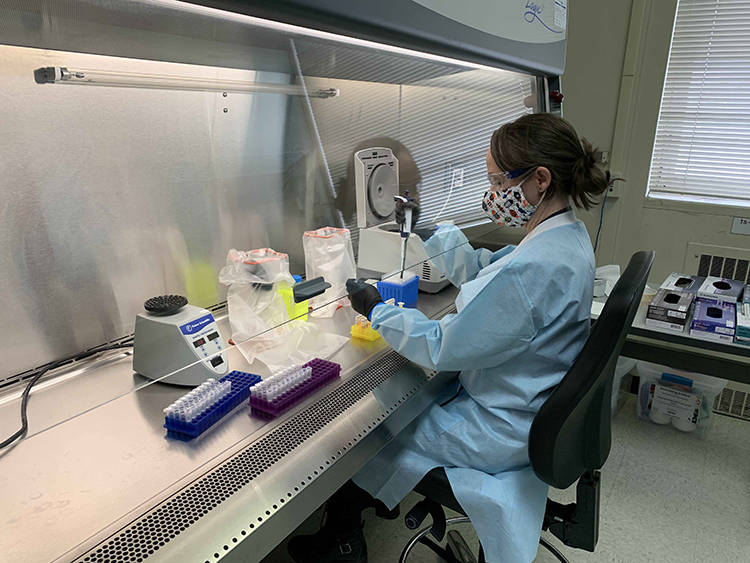Genomics and Bioanalytics Group
Contact Us
- Division Point-of-Contact

A Los Alamos scientists prepares samples for sequencing
Los Alamos has been a leader in genomics for decades
The Genomics and Bioanalytics Group (B-GEN) houses our flagship capabilities in applied genomics, sequencing, and bioinformatics. Our work is founded on our historical contributions to the Human Genome Project, our role as a founding member of the DOE Joint Genome Institute, and our global partnerships in genomics education and training.
Genome science represents a unifying knowledgebase that crosses all domains of biology. Exciting new science in this group spans digital biosecurity, multi-omics, big data analytics, DNA data storage, and signature discovery.
Sample preparation
B-GEN scientists have decades of experience developing advanced protocols to isolate DNA or RNA from a wide range of sample origins to obtain the best quality sequence data.
- Environmental samples:
- Insects (Mosquito RNA transcriptomics)
- Water (Environmental monitoring)
- Wastewater (SARS-COV-2)
- Soil (Climate change and environmental monitoring)
- Surfaces (General laboratory contamination, environmental monitoring)
- Plants (Transcriptomics, whole genome sequencing (WGS), microbiome)
- Animals (Birds, Tortoise, Cats, Dog)
- Algae (WGS, transcriptomes)
- Droppings (Condor, Tiger)
- Clinical samples (humans and animals):
- Respiratory (sputum and swabs for virus)
- Blood (IBS studies, and spike-ins of bacteria)
- Cheek swabs (Human ID)
- Stool (IBS studies and spike-ins of bacterial DNA/RNA)
- Urine (R&D for limits of detection)
- Cerebral spinal fluid (Limit of detection of viral and bacterial signal)
- Tissue biopsies (radiation exposure studies)
Advanced Sequencing Systems
B-GEN maintains and utilizes several advanced sequencing systems:- Next-generation short-read sequencing
- Illumina (NextSeq 500, NextSeq 2000, MiSeq + FGx, iSeq)
- Third-generation, single molecule long read sequencing
- PacBio (Sequel II, RS II)
- Oxford Nanopore (MinION)
Analysis and Visualization
Bioinformaticists in B-GEN have developed multiple, custom platforms to help analyze and visualize genomics data:
Computational capabilities that support these efforts include:
- Languages: Python, R, Java, Perl, C++, etc.
- Mainstream open source bioinformatics tools
- A multitude of custom pipelines for analysis of big data
The B-GEN group operates its own custom, high performance computing environment specifically tailored to bioinformatic analysis:
- Genome science-specific infrastructure
- >100 servers with >3000 cores, >12TB RAM
- ~1.5 PB parallel storage space
- ~1.5 PB tape archive storage space
- Notable resources
- Dell T640 (40 cores, 2x RTX Titan GPUs)
- Dell R910 (40 cores, 1TB RAM)
- 2 x Dell 920 (80 cores, 1TB RAM)
- IBM X3850 (80 cores, 2 TB RAM)
- LANL HPC supercomputing
Recognized as a leader in genomic sequencing and analysis for decades, the Los Alamos capability now spans all ‘omics research to study proteins, transcripts, metabolites, and phenotypes. By combining techniques in genomics and mass spectrometry, B-Division is working towards a true systems-level characterization of biological organisms.
- We can measure and analyze of all of the DNA, RNA, proteins, and metabolites functioning in a biological system
- Our scientists are applying this expertise to multiple areas of interest:
- Countermeasure development
- Improving bioenergy/biomanufacturing feedstocks
- Analyzing the impacts of environment perturbations & climate change
- Understanding the three-dimensional structure of chromosomes over time and the manifestation of epigenomic changes
Scientists in B-GEN use their genomics expertise to tackle understanding some of the most complex microbial communities in the world. Many of these projects involve large, multi-disciplinary and multi-institution teams:
B Division scientists are working to understand and mitigate disease outbreaks in complex environments in many capacities:
- Developing methods to enhance human health and agriculture monitoring.
- Next-generation detection of biological and chemical threats
- Biomarker and signature discovery
- Reagent and assay development and validation
- Health analytics
- Next-generation detection of biological and chemical threats
- Studying the impacts of climate on disease emergence and spread in the Ecological Health Security Lab.
- Establishing worldwide trainings in genomics capabilities, collaborations, and bioinformatics to create a network for reliable data analysis and sharing.
- Maintaining a Biosurveillance Gateway website to share capabilities and health analytics platforms such as:
- AIDO
- RedAlert
Los Alamos advances in bioenergy production and biomanufacturing are built on decades of leadership in genome sequencing and analysis. Bioscience Division scientists have cultivated a complete set of laboratory tools and scientific expertise to fuel the growing bioeconomy.
Species-specific tools developed at Los Alamos are key to creating biofuels/bioproduct-optimized, transgenic algae and plants. Examples of these tools include:
- Telomere-to-Telomere Genome Assembly
- Transcriptome analysis to find native promoters
- Custom expression vectors with native promoters and terminators
- Novel transformation techniques
- High throughput flow cytometry and advanced sorting techniques for strain screening and isolation
- Advanced bioinformatics for multiomics measurements
Bioscience Division Resources
DOE Science Focus Areas
- Terrestrial Microbial Carbon Cycling
- Bacterial-Fungal Interactions and Their Roles in Ecosystem Health
Partnerships and Outreach
- National Microbiome Data Collaborative
- Annual Sequencing to Function: Analysis and Application for the Future Meeting
- Bioscience Division hosts an annual bioinformatics training for international collaborators
- Los Alamos participates in the annual Joint Science and Technology Institute West





